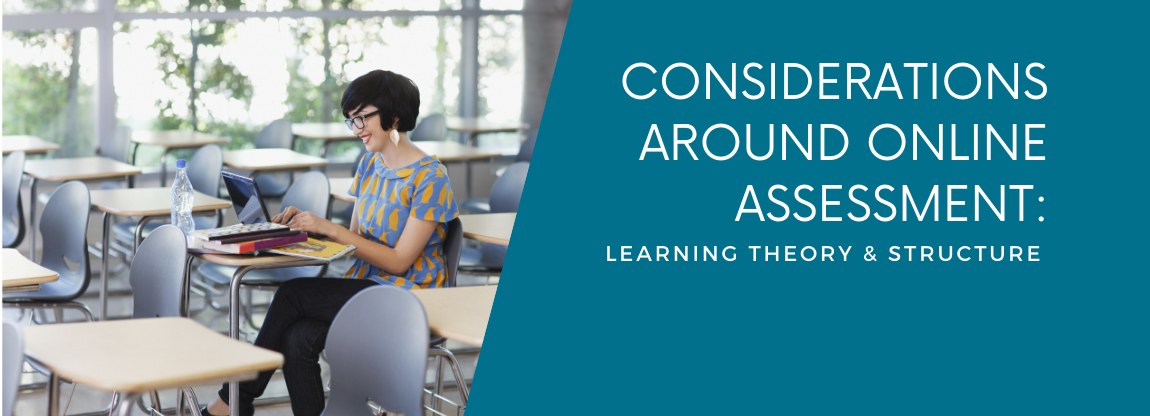Considerations around Online Assessment: Learning Theory and Structure
Delivering lectures virtually is one hurdle educators over the world are facing. A further area to explore is how to keep on top of the quality of students’ learning through assessment.
All assessments lead to some amount of student learning, but an elementary challenge lies in stimulating the right kind of learning. How can educators design assessment practices that send the right signals to students – about what they should learn and how they should learn.
In this article, we look at the foundations of what could be considered before setting up an assessment structure that works for you and your learners.
Before starting, think about the pedagogy
A useful starting point for thinking about online assessment is a consideration of learning theories. Whether you adopt a traditional or more contemporary pedagogy, online learning will impact on the design of teaching content and the assessment process. Applying Bloom’s taxonomy to teaching and learning will enable the students to cover the subject area from low-level to higher-level. Since the higher levels requires a more complex understanding, a progressive assessment approach can be adopted. This might involve a mixture of MCQs and essay-type or longer text-based questions with different weighting; this is useful for being able to gauge the level of your learners’ understanding.

As an example of the different levels of questions, you could look to include (from lower level thinking to higher) questions akin to:
- Filling in missing parts of a definition, simple calculations, recite key terms, respond to simple MCQs, undertake semi-supported virtual reality tasks.
- Describe the scope of a concept, show evidence of a calculation process, outline stages/steps in a process, clarify the subject terms in MCQs, write a 250-word account of the theories you are applying.
- Write a 500-word article about an aspect of the topic for an industry magazine, write a 750-word investigative report, write a 1250 account of a topic.
- Write a 1500-word report analysing a topic critically indicating how it compares to a similar case, respond to extended MCQs that question theories about a topic in a broader context, undertake extended virtual reality tasks, write a 500-word reflection on concepts.
Learning theory and learner preferences
In parallel to thinking about theory, think about your students and engage with them on their preferences. Your students may be struggling in their own worlds and further changes, on top of the disruption they are already facing, can lead to additional stress. Early communication with them around different styles of assessment they’ll be facing would reap rewards and heightened engagement with the assessment path you take.
You may have groups of students as part of Student-Staff committees who you could speak to in order to gauge preference opinions and thoughts. Or perhaps engage a handful of learners across a blend of abilities and ask for their opinion. Getting them to share what they think about their exams could be a valuable exercise in getting them on board with the process.
Seeking student opinion, as co-creators, will encourage their buy-in as stakeholders and can pay dividends in getting them to understand the rationale behind the assessment design and structure.
This could involve:
- Exploring what they think about splitting exams into shorter progressive chunks as opposed to long ones: would that be something they would be happy with?
- Asking them to rank their preferences in terms of question-types. This will give you an opportunity to see their preferred options, whilst also opening a dialogue around exam security.
- Identifying their thoughts about how we deploy digital tools that prevent cheating.
On structure, you can consider:
- How often should you check in on your students’ learning?
- What types of assessments are suitable at different levels and stages of learning?
- How can you deploy complimentary summative and formative assessments?
- How often should you assess formally?
- How can you distribute the marks and weighting across the range of assessment?
The outcomes of this engagement will depend on student dynamics and will need reviewing on a case-by-case basis. But one thing is for sure, if you’ve explained why you’re doing things differently, via an open dialogue, students should at least feel supported and understood; and you can feel confident in your approach towards online pedagogy that embraces progressive levels or learning and assessment.
The topics covered in this blog post are taken from a series of two Professional Development webinars held by McGraw Hill and hosted by Bo van der Rhee of Nyenrode Business University and Caroline Ennis of Birkbeck University.
For more information on how McGraw Hill can support you in navigating online exam assessment, please reach out to our education consultant. Thinking about making the transition to online learning, watch McGraw Hill Asia's on demand webinars as they address topics around remote course delivery.


